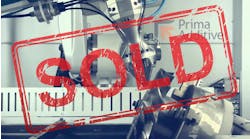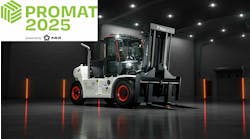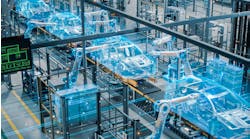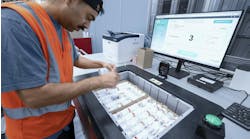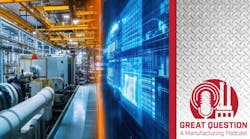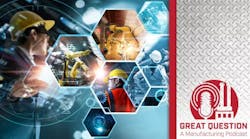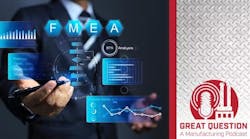Latest from Software & Computers
Podcast: How to Avoid Digital Transformation Pitfalls
To get straight answers on navigating digital transformation challenges, Scott Achelpohl, managing editor at Smart Industry spoke with Francisco Almada Lobo, CEO and co-founder of Critical Manufacturing. As a recognized thought leader in Industry 4.0 and modern manufacturing operations, actively involved with groups like the SEMI Smart Manufacturing Technology Committee and the Forbes Technology Council, Francisco shared crucial insights on integrating AI and MES systems effectively and avoiding the common missteps that can derail digitalization efforts.
Below is an excerpt from the podcast:
SI: At Smart Industry, we cover Industry 4.0 a lot—saying that is an understatement. Digital transformation is one of our hallmark topics. I’ll mention that our (R)Evolutionizing Manufacturing video series with industry enthusiast Jeff Winter—who also happens to be an employee of Critical Manufacturing—is our primary platform for this. So, we’re happy to have Francisco’s voice today.
For our audience, the many companies we serve, digital transformation can sometimes feel like a culture shock, and the process can be quite involved and expensive. These companies want it done correctly so resources and personnel aren’t wasted. So, we want to advise them on how to get it right. I’m hoping Francisco will help us answer the questions: Are manufacturers achieving real transformation, or are they simply layering more technology on top of existing inefficiencies? It's an important question we posed.
So Francisco, let me ask you a few questions to get our chat started. We spoke in our run-up to this program about how a lot of companies take a gradual, staged, or step-by-step approach to digital transformation. What’s your advice on this? What should be the starting point? What are some middle steps, and what are the end goals? Where can companies get off track during this process?
FAL: Great question! So, let me start by saying something that is often overlooked: companies should begin by reviewing and streamlining their processes. One of the most expensive mistakes companies can make is to start by simply digitizing their current processes—what we call “paper on glass.” We’ve had customers who started an MES or AMES project and began by streamlining their processes. Interestingly, they immediately gained a significant portion of the project’s ROI even before the system was fully operational. So this is very important.
Then, the second aspect, which is more closely related to your question, is that there’s nothing wrong with the step-by-step approach to digitalization—quite the contrary, as long as there is a global vision of what you want to achieve, and the basic infrastructure is in place. The issue is that today, digitalization infrastructure isn’t just about computers or networks; it includes back-office systems that support step-by-step implementation.
To use an analogy, it’s like building a house. You first need strong foundations, solid framing, and essential infrastructure like plumbing and electricity. Only once these elements are securely in place can you confidently add smart home technology, advanced automation, and sophisticated gadgets. If you don’t, and you start with just the gadgets for a specific use case or pilot, you’ll end up in "pilot purgatory"—where solutions don’t scale, can’t evolve, or can’t adapt to ever-changing requirements. This is definitely not the way to go.
SI: Francisco, how does Critical Manufacturing recommend companies go about digital transformation, and how do its products specifically tie into this process?
FAL: Great point. In industrial operations, there’s always been talk about the “Holy Grail” of solutions: ERP for managing production orders, PLM systems for managing products, and MES for managing execution. How these three elements connect has been a longstanding challenge. But today, with increasing levels of automation and more data coming from machines on the shop floor, there are added solutions—like equipment integration platforms or IoT platforms—that must be fully integrated with the MES. These are now part of the basic infrastructure I mentioned earlier.
We strongly believe that it’s the combination of these three backbones—equipment connectivity, data platforms, and MES—that creates the foundational technology for digital transformation and Industry 4.0. The idea is that when you have equipment connectivity and data, we can enable bidirectional communication to support interlocking scenarios or download programs for more sophisticated equipment. This connectivity, combined with the data platform, allows for large amounts of data to be ingested, analyzed, and used to generate insights that help optimize production.
When all these systems work together—efficiently and harmoniously—that’s when the magic happens. If systems are open and composable, you can plug in technologies like virtual reality, augmented reality, digital twins, bots, and advanced AI to enhance functionality.
At Critical Manufacturing, we call our solution an “MES on steroids,” as it goes beyond execution and includes advanced equipment connectivity and data platform elements.
About the Podcast
Great Question: A Manufacturing Podcast offers news and information for the people who make, store and move things and those who manage and maintain the facilities where that work gets done. Manufacturers from chemical producers to automakers to machine shops can listen for critical insights into the technologies, economic conditions and best practices that can influence how to best run facilities to reach operational excellence.
